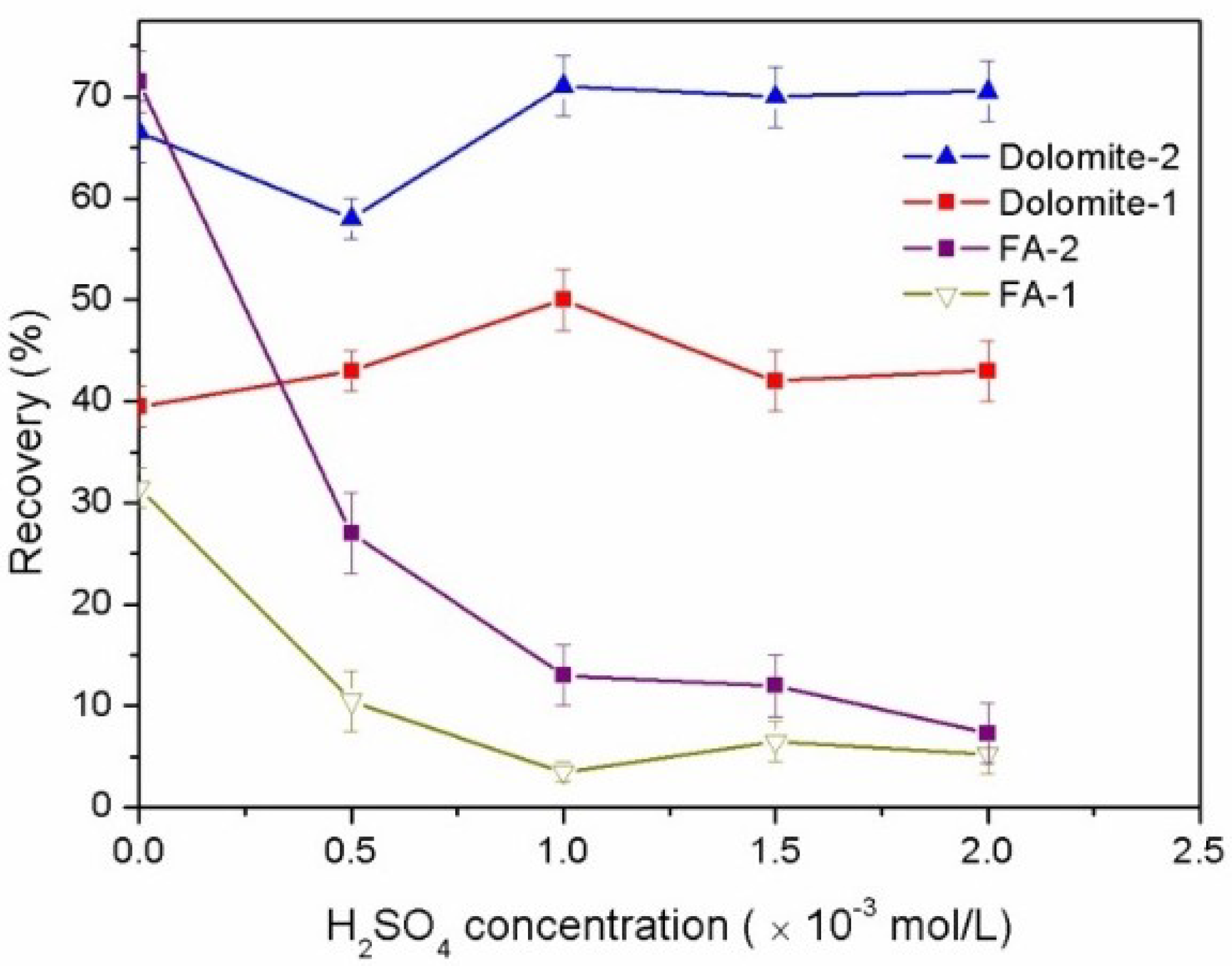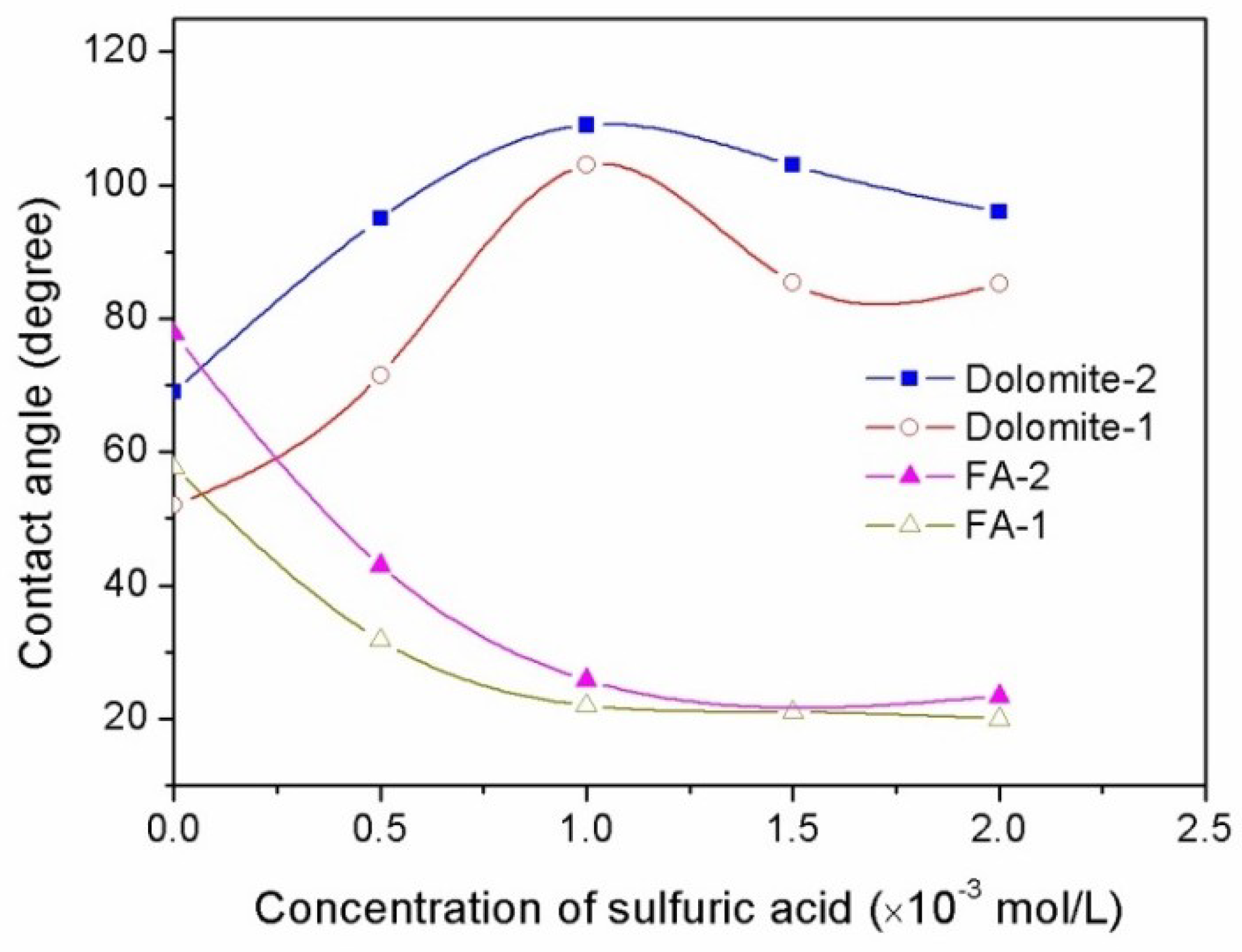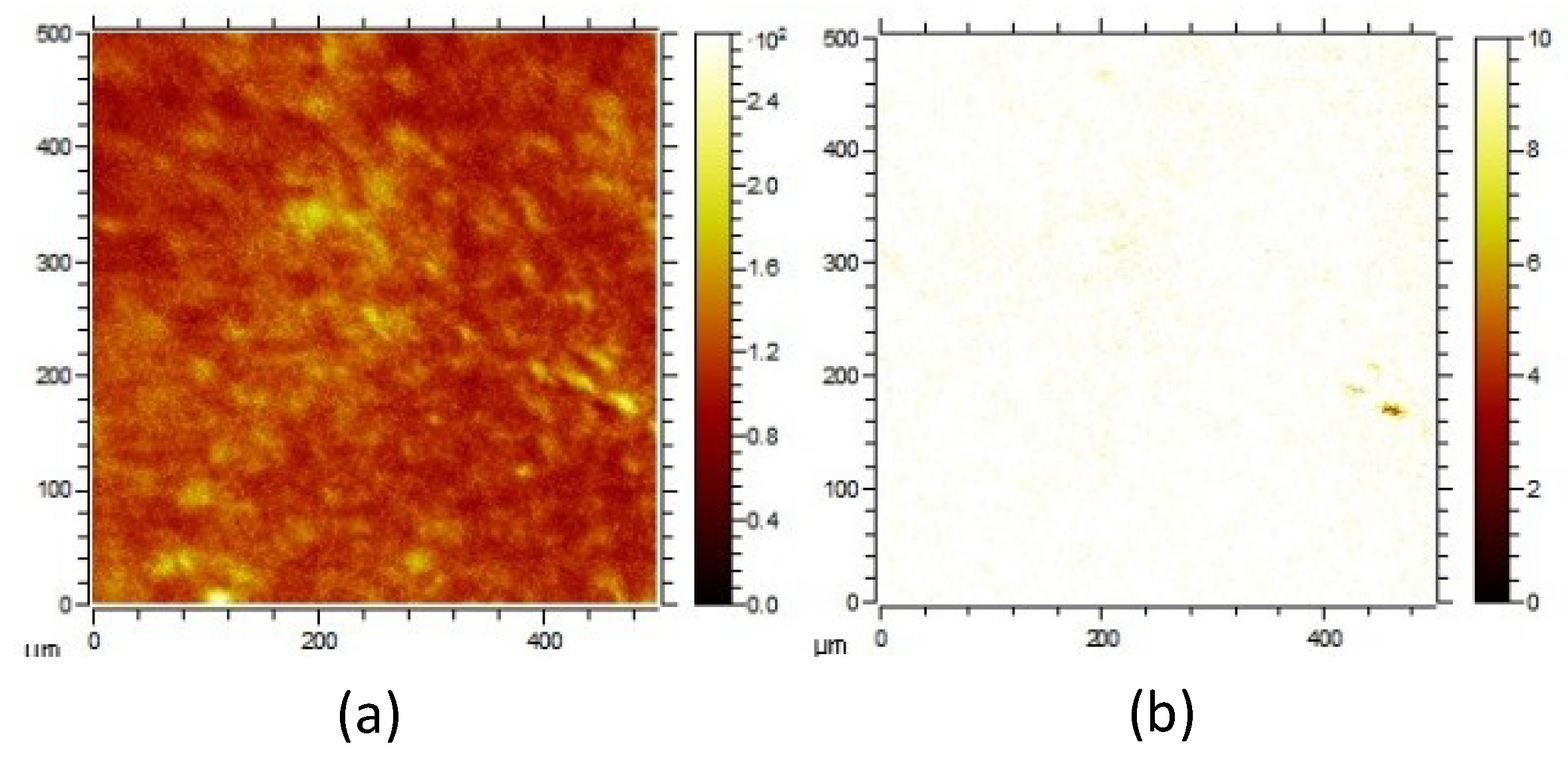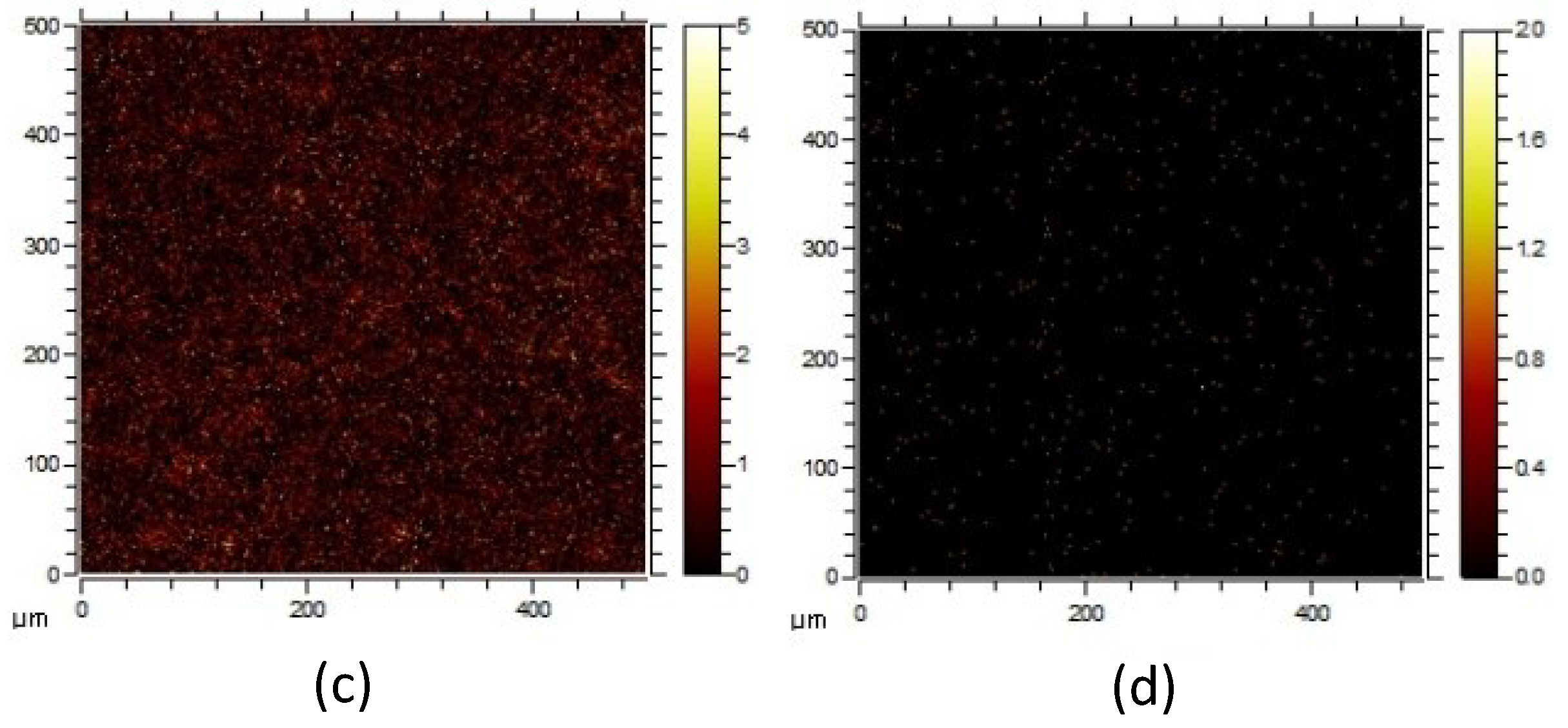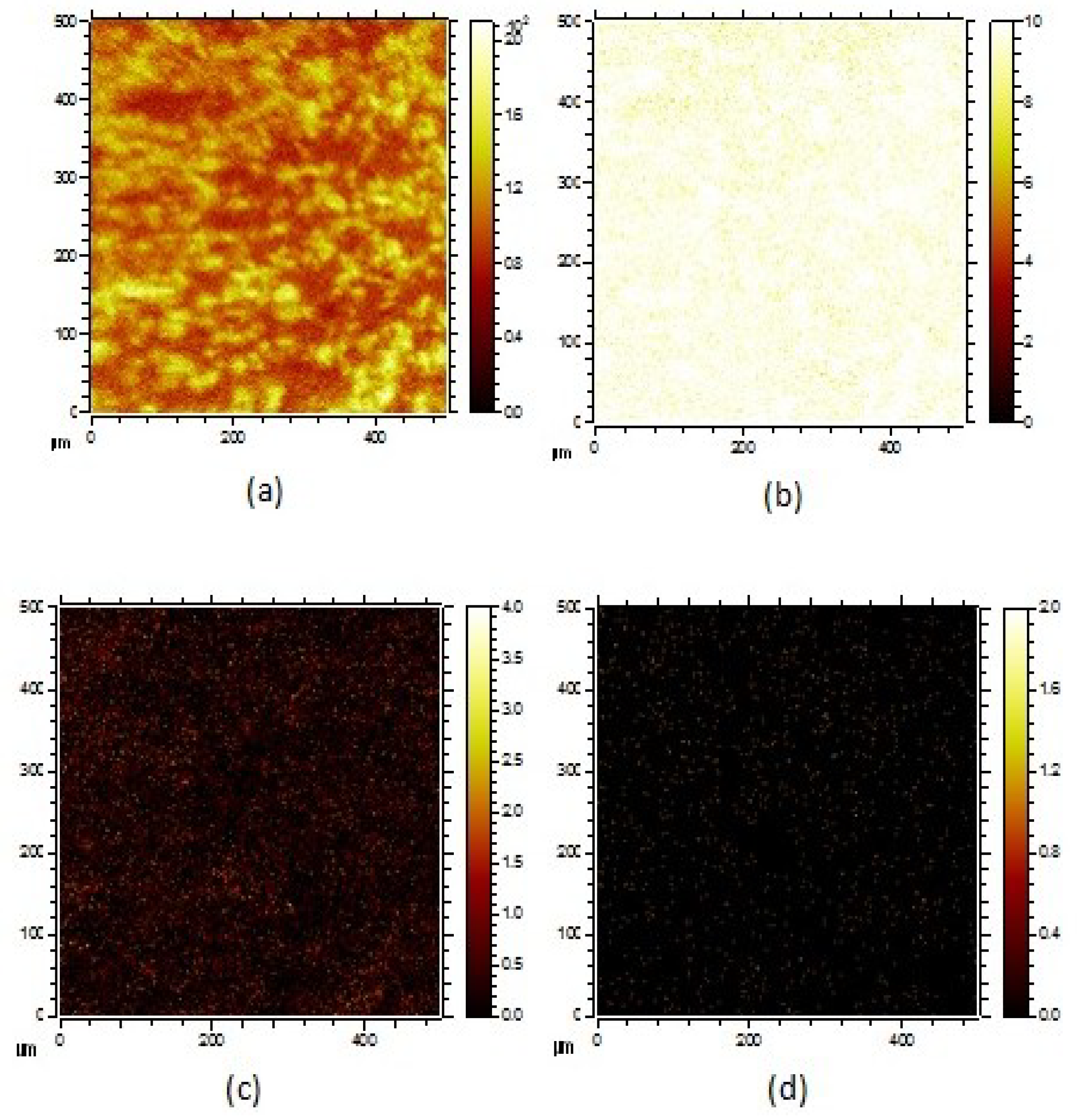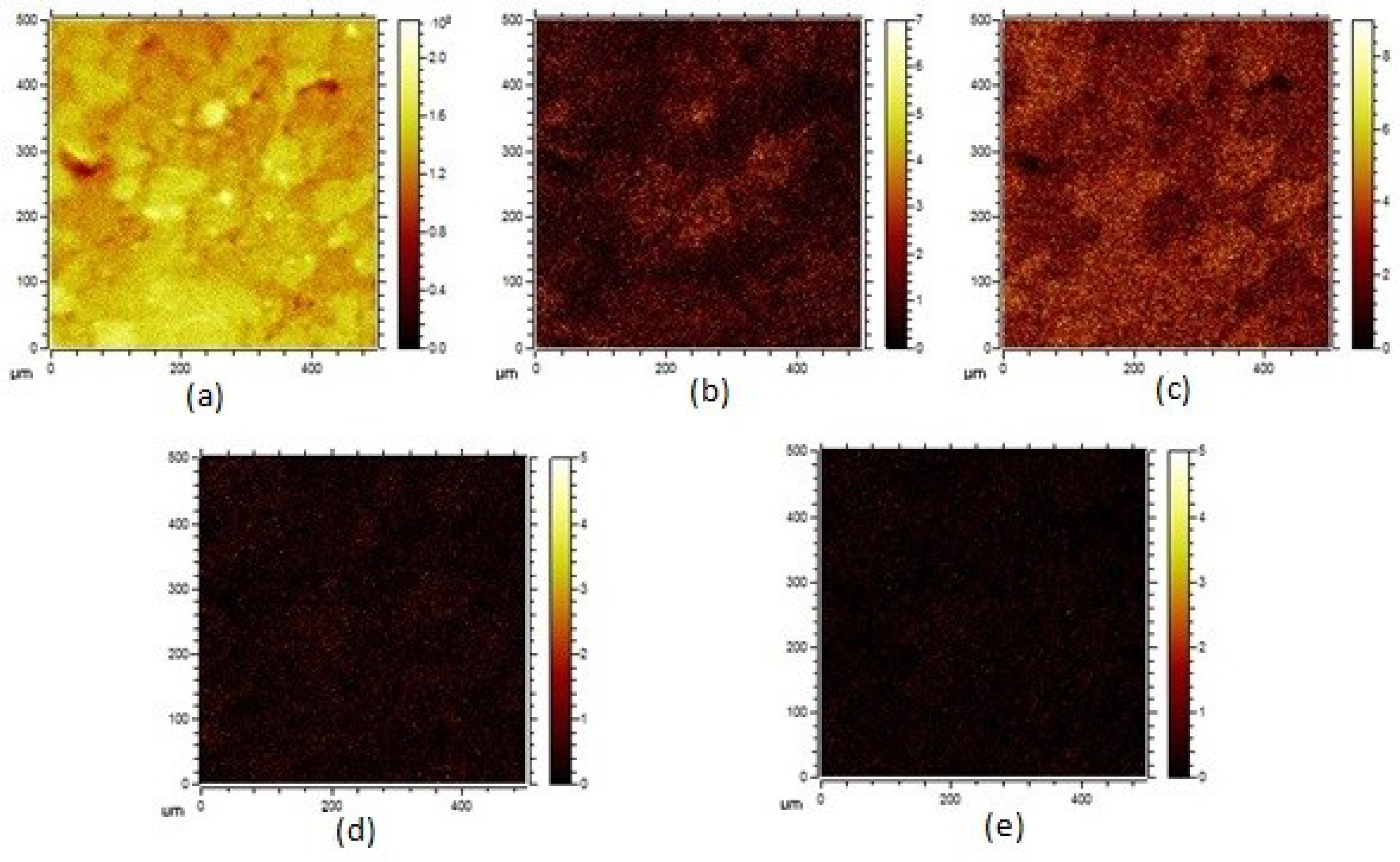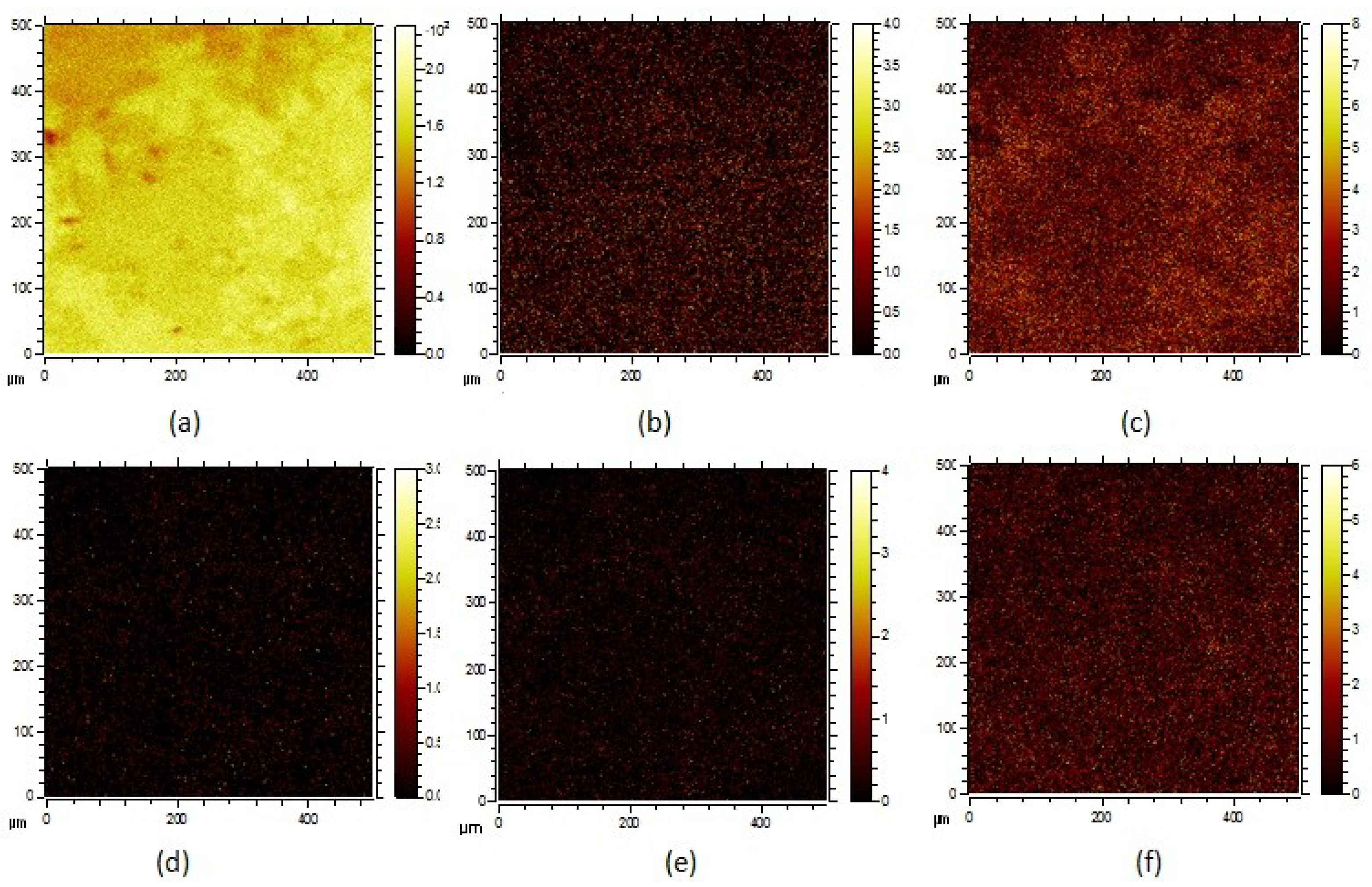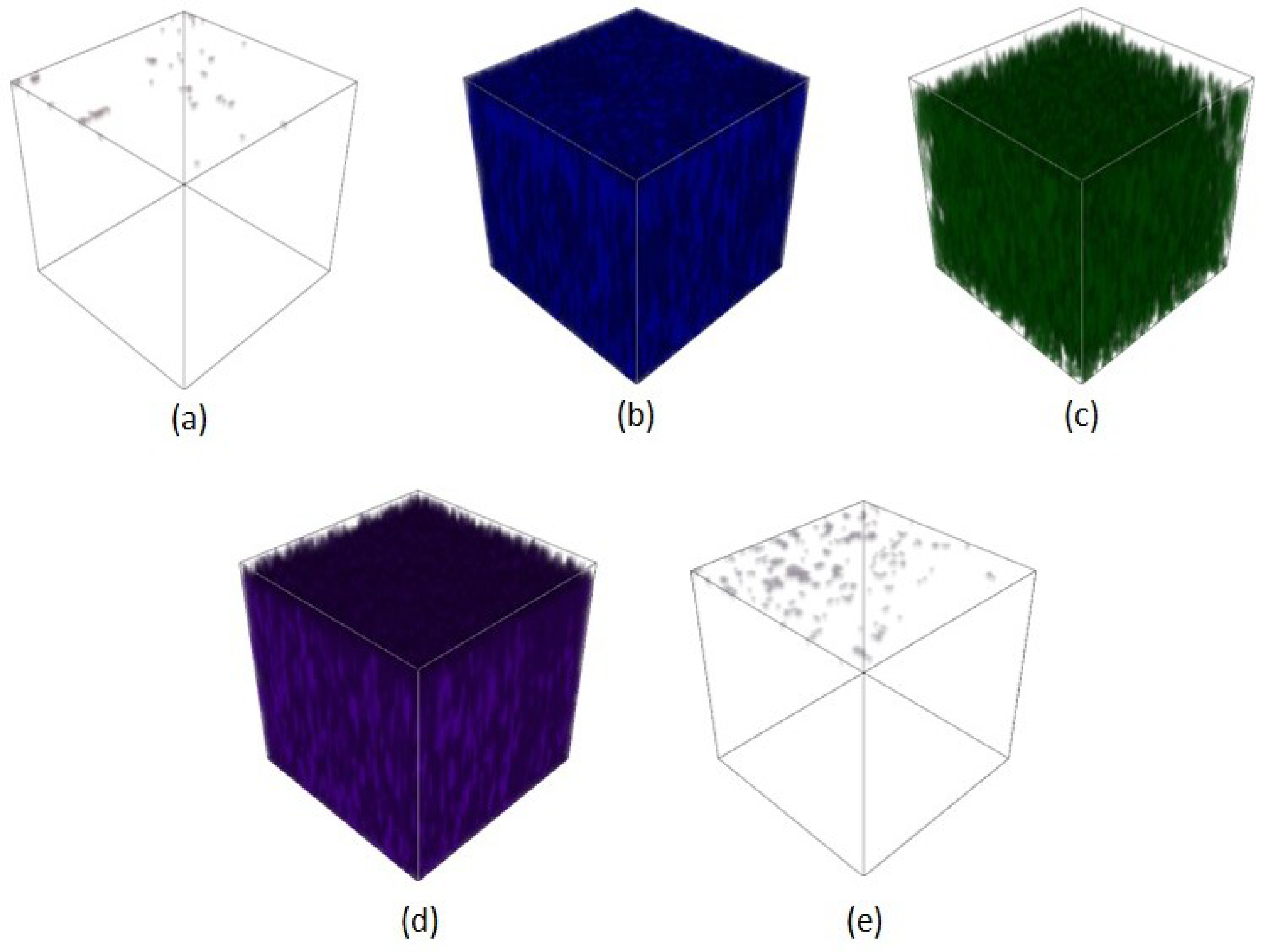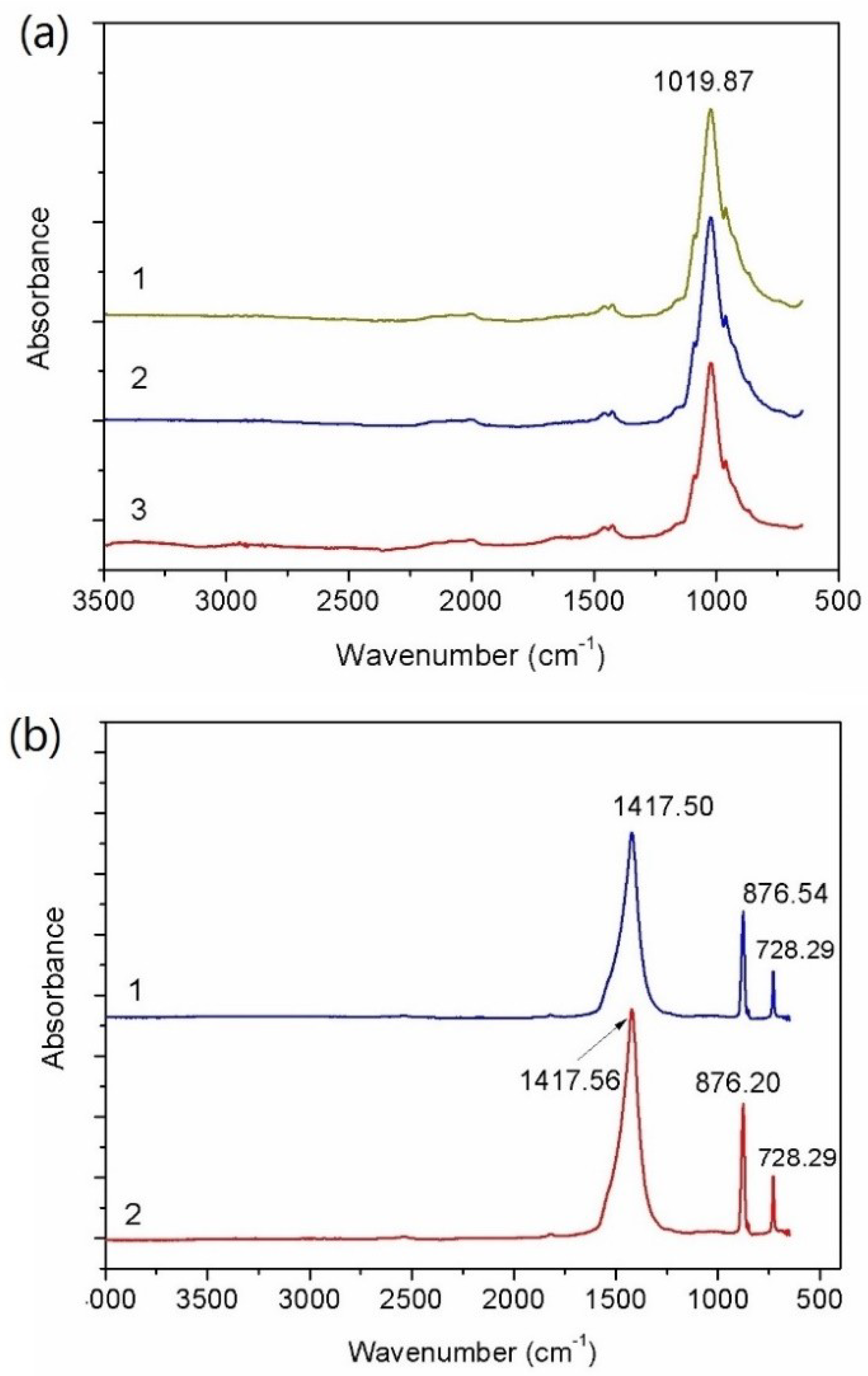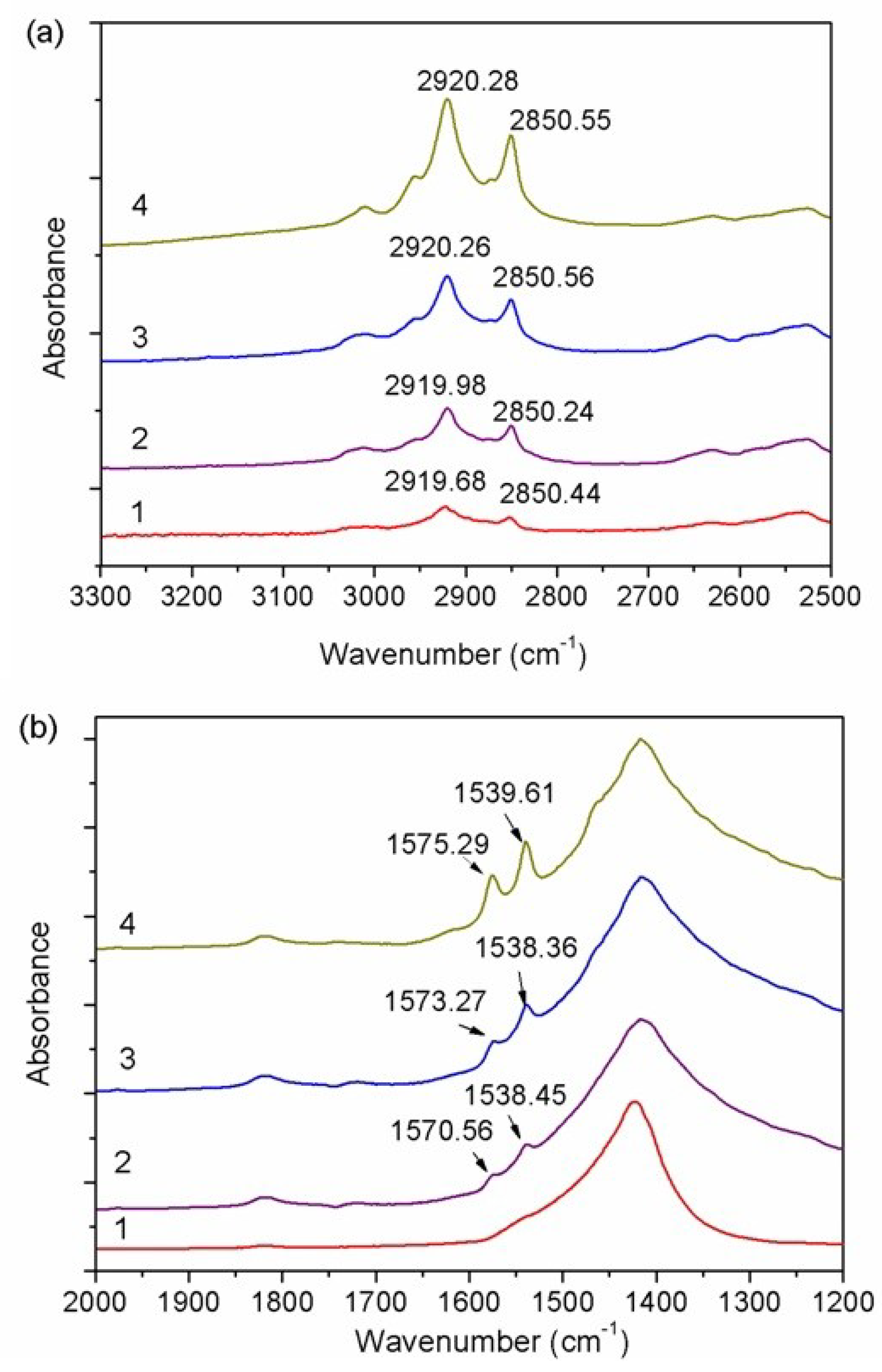3.1. Flotation Behavior
The influence of the H
2SO
4 dosage on the FA/dolomite flotation was examined using a laboratory mechanical flotation-machine. The flotation results only with oleate at natural pH (about 6.5) are also reported. In terms of FA, the recovery was about 30% with 1 × 10
−4 mol/L of oleate at the natural pH (
Figure 1), consistent with a previous report [
12]. Moreover, the condition with H
2SO
4 led to an obviously reduction in FA recovery; the FA recoveries were <10% when the H
2SO
4 concentration was ≥1 × 10
−3 mol/L. A similar trend was found for FA with 2 × 10
−4 mol/L of oleate, FA could not be efficiently collected by the collector when the H
2SO
4 concentration was ≥1 × 10
−3 mol/L.
In contrast, the treatment with H2SO4 slightly improved the flotation of dolomite. At each examined collector concentration (1 × 10−4 mol/L and 2 × 10−4 mol/L), the recovery of dolomite treated with 1 × 10−3 mol/L H2SO4 increased by 5–10% compared to that without H2SO4 treatment.
The carbonate ions on the dolomite surface are unstable in acidic solution and can be dissociated into H
2O and CO
2. Thus, a considerable number of metal ions on the surface might be exposed to the solution, thereby providing substantial adsorption sites for the adsorption of oleate. Moreover, the dissolved metal ions may also favor the adsorption of collector to some extent [
8]. In this regard, the treatment with H
2SO
4 could slightly enhance the dolomite flotation using oleate as a collector.
In addition, the separation of dolomite from FA was further investigated by the flotation tests using a 1:1 mixture of dolomite and FA. The concentration of oleate was 2 × 10
−4 mol/L in such tests. The recovery of MgO was close to that of P
2O
5 in the absence of H
2SO
4, suggesting that oleate is not a selective collector for this flotation system (
Table 1). While, the addition of H
2SO
4 into the slurry deteriorated the FA flotation. Moreover, the P
2O
5 recovery was <10% when the H
2SO
4 concentration reached 2 × 10
−3 mol/L. It appears that more H
2SO
4 was required to depress FA in the flotation of FA-dolomite mixture, comparing with that in the single-mineral flotation of FA, while the MgO recoveries were over 69% regardless of the H
2SO
4 concentration. Such results demonstrate again that H
2SO
4 can be used as a specific depressor for FA.
3.2. Contact Angle Measurements
The difference in the hydrophobicity of minerals determines the separation efficiency of the flotation technique. The hydrophobicity of FA can be measured with the contact angle method [
13]. In this work, this method was used to determine the hydrophobicity of FA/dolomite treated with H
2SO
4 and oleate.
Figure 2 shows that the contact angle of FA sharply decreased with an increase in H
2SO
4 concentration. When the FA was treated with 1 × 10
−3 mol/L of H
2SO
4, the contact angle was below 25° using 1 × 10
−4 or 2 × 10
−4 mol/L of oleate. These results imply that the usage of H
2SO
4 may prevent the adsorption of oleate species onto the FA surface, thereby allowing the FA surface to maintain a hydrophilic state in the slurry.
In contrast, the addition of H
2SO
4 into the slurry improved the contact angle of dolomite with 1 × 10
−4 or 2 × 10
−4 mol/L of oleate, which is in line with the above flotation results. For each oleate concentration, the contact angle reached the maximum value with 1 × 10
−3 mol/L of H
2SO
4. When the concentration of H
2SO
4 was above 1 × 10
−3 mol/L, the contact angle of dolomite was lower than that with 1 × 10
−3 mol/L of H
2SO
4. The pH of dolomite slurry with 5 × 10
−4 or 1 × 10
−3 mol/L of H
2SO
4 was approximately 5.5 (
Table 2). However, with 1.5 × 10
−3 or 2 × 10
−3 mol/L of H
2SO
4, the pH of dolomite slurry was in the pH range of 4–5, and precipitation of oleate was observed in the solution. Therefore, oleate species cannot efficiently adsorb on the dolomite surface to produce a highly hydrophobic surface.
The gap in contact angles between FA and dolomite was approximately 83° when the FA and dolomite were treated by 1 × 10−3 mol/L of H2SO4 and 2 × 10−4 mol/L of oleate. Under these conditions, dolomite can be floated by oleate prior to FA. These results further demonstrate that H2SO4 can be used as a depressor for FA, in accordance with the reverse flotation phenomenon in phosphate plants.
3.3. TOF-SIMS Analysis
TOF-SIMS is a highly sensitive technique to determine the 2D/3D distributions of chemical fragments on a solid surface. A beam of primary ions, such as bismuth ions, is used to bombard the solid surface using the TOF-SIMS technique. Atoms or molecular fragments on the solid surface can overcome the surface binding energy to generate secondary ions/molecular fragments due to atomic collisions [
14]. According to the mass spectroscopy of the secondary ions/molecular fragments, the distribution of these species on the solid surface can be remodeled [
15]. This technique has been successfully used to investigate the surface characters of some minerals in their flotation system [
16]. In this context, this method was used to determine the surface features of FA/dolomite conditioned with H
2SO
4 and oleate.
3.3.1. FA Surfaces
When the H
2SO
4-treated FA surface was bombarded with the Bi
3++ primary ions, three types of secondary ion, namely, PO
3−, SO
4−, and CaO
−, were emitted from the FA surface (
Figure 3). Evidently, CaO
− and PO
3− came from the original FA surface. The presence of SO
4− was due to the adsorbed SO
42− ions on the FA surface. It is believed that SO
42− ions interacted with Ca
2+ on the FA surface.
On the FA surface treated with H
2SO
4 (1 × 10
−3 mol/L) and oleate (2 × 10
−4 mol/L), PO
3−, SO
4−, and CaO
− species were measured, and their distributions were found to be similar to those on the FA surface only conditioned with H
2SO
4 (
Figure 4). Moreover, the molecular fragments related to oleate were not detected on the FA surface, thereby indicating that oleate did not occur on the FA surface treated with H
2SO
4.
Figure 5 further illustrates the 3D results of PO
3−, SO
4−, and CaO
− species on the FA surface conditioned with H
2SO
4 and oleate. It was found that PO
3− and CaO
− were well distributed in the bulk phase of FA. In contrast, SO
4− only presented on the top of the FA surface in an island-like structure.
According to the TOF-SIMS and flotation results of the FA samples, it is reasonable to expect that SO42− ions reacted with Ca ions on the top of the FA surface to generate CaSO4 species. Consequently, oleate cannot further adsorb onto the Ca sites on the H2SO4-treated FA surface; hence, a poor FA recovery was obtained.
3.3.2. Dolomite Surfaces
With regard to the dolomite surface treated with 1 × 10
−3 mol/L of H
2SO
4, the secondary ions, including CO
3−, CaO
−, and MgO
−, from the original dolomite surface were measured by the TOF-SIMS method (
Figure 6). The SO
4− was also present on the H
2SO
4-treated dolomite surface. These results revealed that SO
42− can also adsorb on the dolomite surface. However, the amount of SO
4− on the dolomite surface was less than that of CO
3−.
When the H
2SO
4-treated dolomite was further conditioned with oleate, SO
4− ions were still found on the mineral surface along with CaO
−, MgO
−, and CO
3− ions (
Figure 7). Furthermore, a new molecular fragment (i.e., C
2H
3O
2−) was measured on the dolomite surface. Evidently, the bombardment of the Bi
3++ beam to the oleate species broke the oleate molecule, thereby resulting in the generation of C
2H
3O
2−. Moreover, the amount of C
2H
3O
2− was evident on the dolomite surface, suggesting that oleate species and SO
42− can simultaneously adsorb on the dolomite surface. In other words, the presence of SO
42− on the dolomite surface did not prevent further adsorption of oleate. The 3D distribution results of these secondary ions/molecular fragments are summarized in
Figure 8. Notably, SO
4− and C
2H
3O
2− islands were located on the top of the H
2SO
4-treated dolomite surface, while other ions were found throughout the entire measured region.
Ca2+ and Mg2+ ions exist on the dolomite surface. Similar to that on the FA surface, SO42− could also bind with Ca2+ on the dolomite surface forming surface CaSO4 species. Mg2+ on the dolomite surface cannot react with SO42− due to the high solubility of MgSO4. Thus, Mg sites on the surface were valuable for the adsorption of oleate. As previously mentioned, Ca2+ and Mg2+ on the deeper layer of mineral surface may have been exposed to the solution due to the dissociation of CO32− on the dolomite surface, which could also provide adsorption sites for oleate. In both events, oleate species can occur on the H2SO4-treated dolomite surface to generate a hydrophobic mineral surface.
Moreover, it seems that the measured density of SO4− on the dolomite surface was lower than that on the FA surface. The dissolution of the dolomite surface in the H2SO4 solution may release Ca2+ ions into the solution. In the bulk solution, Ca2+ ions could bond to SO42− to preferentially form a bulk precipitation of CaSO4. As a result, a portion of SO42− ions in the solution was consumed, resulting in a relatively low adsorption density on the dolomite surface.
3.4. FTIR Study
As stated in the Introduction section, the adsorption state of oleate species on a calcium-bearing mineral surface highly depends on the oleate concentration. In this section, the ATR-FTIR method was used to determine the oleate species on the dolomite surface at selected oleate concentrations. The ATR-FTIR spectra of FA samples were also measured for comparison.
Figure 9 summarizes the ATR-FTIR spectra of FA samples. In the spectrum of natural FA, the intense band at 1019 cm
−1 can be assigned to the asymmetrical stretching vibration PO
43− group [
17]. This band was also observed in the spectrum of FA treated with H
2SO
4 (1 × 10
−3 mol/L). Unexpectedly, the characteristic peaks of SO
42− were not found for FA treated with H
2SO
4. The results show that FTIR is less sensitive in detecting the CaSO
4 species on FA surface compared with the TOF-SIMS technique. In terms of FA treated with H
2SO
4 (1 × 10
−3 mol/L) and oleate (2 × 10
−4 mol/L), the spectrum was similar to that of the natural FA. The characteristic peaks of the CH
2 and CH
3 vibrations did not occur in the spectrum. It appears that oleate cannot adsorb onto the FA surface conditioned with H
2SO
4, which is in accordance with the abovementioned TOF-SIMS results.
In the ATR-FTIR spectrum of the natural dolomite (
Figure 9), the band at 1417 cm
−1 was due to the asymmetric stretching of CO
3 in dolomite. The peaks at 876 cm
−1 and 729 cm
−1 were attributed to the vibrations of CO
3 of dolomite [
18]. The peak at approximately 729 cm
−1 was commonly used to distinguish dolomite from calcite [
18,
19]. Similar to the FTIR results of the FA sample, the spectrum of dolomite treated with H
2SO
4 was almost the same as that of natural dolomite. It is expected that the concentration of CaSO
4 on dolomite surface was particularly limited to measurement by the ATR-FTIR method.
In terms of dolomite treated with H
2SO
4 (1 × 10
−3 mol/L) and further with oleate (1–3 × 10
−4 mol/L), two new adsorption bands at 2850 cm
−1 (symmetry stretching of CH
2) and 2920 cm
−1 (asymmetry stretching of CH
2) were observed in the spectrum (
Figure 10) [
20,
21]. Furthermore, the intensities of these new bands became stronger with an increase in oleate concentration, which indicates that oleate species were adsorbed on the H
2SO
4-treated dolomite surface.
The characteristic peaks of oleate species are in the range of 1800 cm
−1 to 1300 cm
−1 [
10]. In the case of dolomite conditioned with 1 × 10
−4 mol/L of oleate, the adsorption of oleate could not generate any new peaks in this wave number range. It seems that the adsorbed amount of oleate on the dolomtie surface was limited with 1 × 10
−4 mol/L of the oleate, which cannot generate an IR signal in the spectrum from 1800 cm
−1 to 1300 cm
−1.
A doublet at 1570 cm
−1 and 1538 cm
−1 was found for dolomite with 2 × 10
−4 mol/L of oleate (
Figure 10). Furthermore, the peak at 1570 cm
−1 shifted to a higher wave number side with an increase in oleate concentration. In contrast, the position of the peak at 1538 cm
−1 barely changed in the examined oleate concentration range. Lu et al. assigned the doublet at 1574 cm
−1 and 1538 cm
−1 to the asymmetric vibration of carboxylate of Ca(OI)
2 on the FA surface [
10]. The vibration of carboxylate stretching of Mg(OI)
2 also occurs at approximately 1572 cm
−1 [
22]. It is possible that Mg(OI)
2 and Ca(OI)
2 can exist on the H
2SO
4-treated dolomite surface. It seems that SO
42− cannot bind with all the Ca
2+ on the dolomite surface. Again, this may be caused by the dissociation of CO
32- on the dolomite surface; a considerable number of Ca
2+ ions can exist on the top of dolomite surface, and thus SO
42− ions cannot interact with all the Ca
2+ ions on the surface. Therefore, oleate can still adsorb onto some Ca sites on the dolomite surface to form precipitation of Ca(OI)
2. On the other hand, it is also possible that the bulk precipitation of Ca(Ol)
2 could adsorb onto the dolomite surface phycially.
Although it was difficult measure the CaSO4 species on the FA/dolomite surface with the ATR-FTIR method, the oleate species on the dolomite surface can be determined using this method. In addition, the above contact angle tests suggest that the contact angle of H2SO4-treated dolomite was approximately 110° with 2 × 10−4 mol/L of oleate. At this oleate concentration, Mg(OI)2 and/or Ca(OI)2 was measured on the mineral surface. Thus, it is concluded that the precipitation of Mg(OI)2 and/or Ca(OI)2 on the dolomite surface plays an important role in generating a hydrophobic surface.
